Discover the 10 Weirdest Snakes in the World
Key Points
- There are five species of snake that can leap from branch to branch, appearing to fly through the air.
- Many of the weirdest snakes in the world live in Africa and Southeast Asia.
- Some snakes have ‘horns,’ ‘tentacles,’ shovel noses, tails that rattle or paddle, dragon-like scales, strange eyes, and one type appears to have no eyes at all.
Snakes are rather strange animals in general thanks to their bizarre anatomy, but have you ever wondered: what are the most unusual, odd, and absolute weirdest snakes in the entire world? What kind of freaky, fascinating, and otherwise unique serpents could top such a list?
Narrowing them down to just 10 different kinds is a bit of a challenge, but the species listed below are truly the weirdest of the weird. From snakes with extra appendages to snakes that can fly to snakes that live underground and look like worms, you’ll be amazed at just how peculiar they can be!
The following list is arranged in no particular order. All of these snakes are equally weird in their appearances, behaviors, and adaptations, just in different ways!
1. Tentacled Snake (Erpeton tentaculatum)

/Shutterstock.com
We begin our journey into the unusual with the aptly-named tentacled snake. As its name suggests, the tentacled snake has two small “tentacles” protruding from the top of its snout. But are these unique little tendrils just for show, or do they serve some kind of purpose? Well, the tentacles are actually highly sensitive mechanoreceptors that the snake uses to hunt prey!
As a highly aquatic snake, this species spends almost its entire life underwater. Since it’s a reptile, though, it doesn’t have gills to help it stay submerged. Instead, it has evolved to be able to hold its breath for up to 30 minutes at a time! These snakes can technically move (albeit very slowly) on land, but they rarely ever do except to make burrows for themselves in very muddy areas.
Native to Southeast Asia, tentacled snakes usually live in marshes and swamps or near rice paddies. They mainly prefer freshwater, but they have also adapted well to living in saltwater. Although they are venomous, their venom isn’t deadly or particularly dangerous to humans.
2. Flying Snakes (Chrysopelea genus; 5 species)
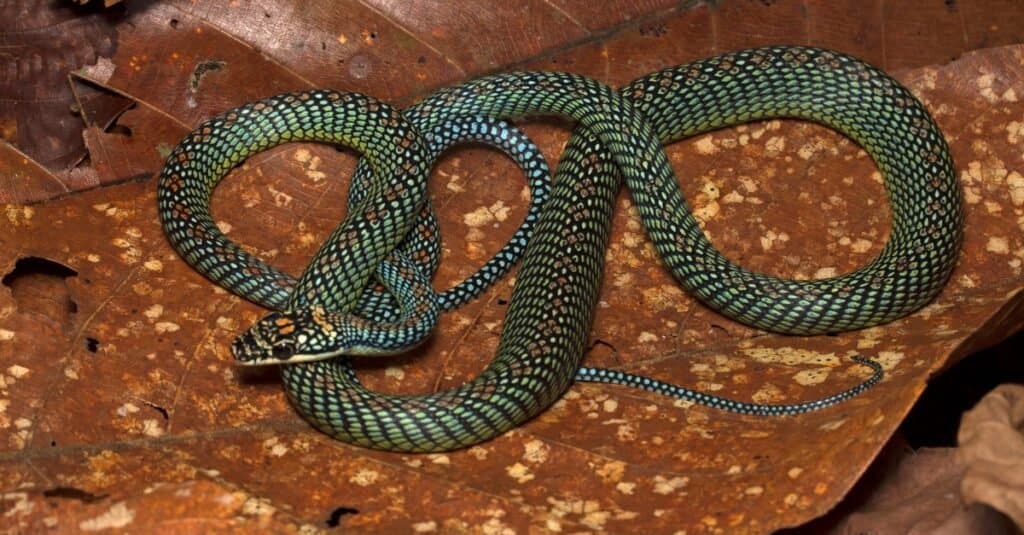
Vince Adam/Shutterstock.com
If the idea of a flying snake terrifies you, you’re certainly not alone! In reality, though, this snake’s name is a bit of an exaggeration. They don’t sprout wings or zoom around like birds of prey by any means. Instead, these highly arboreal snakes are able to flatten their lightweight yet muscular bodies to glide from tree to tree.
The way flying snakes such as the ornately colored paradise flying snake glide is actually very advanced! To put it as concisely as possible, they climb trees using their strong abdominal muscles, and, when they need to hop to another nearby branch (or even another tree entirely!), they will push their bodies up into the air away from the branch and take a huge leap.
Then, while in mid-air, a flying snake will stretch out and flatten its ribs and rapidly undulate its body. These combined motions turn the snake into a sort of makeshift wing, allowing it to quickly yet gracefully glide impressive distances.
There are five species of flying snakes within the Chrysopelea genus, all of which are native to Southeast Asia. They spend most of their lives high up in the canopies of trees in humid, dense jungles and forests.
3. Dragon Snake (Xenodermus javanicus)
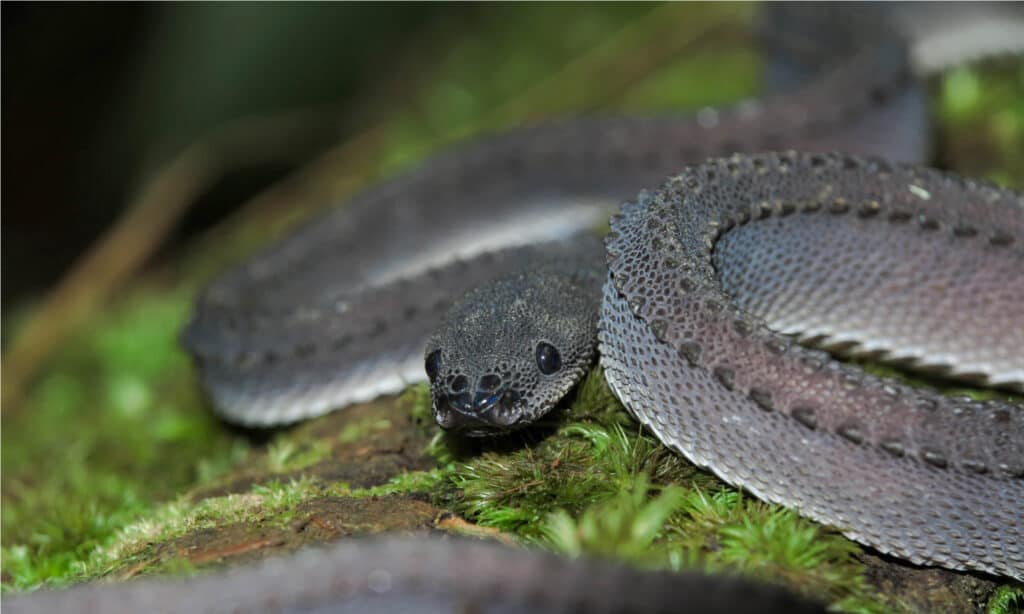
/Shutterstock.com
We started with weird snakes that live in the water, then in trees, and now, we’re on to a species that spends much of its life underground. This strange serpent has several common names, including the Javan mudsnake and Javan tubercle snake, but its most popular moniker by far is simply the dragon snake. It is the sole member of its genus, Xenodermus.
The dragon snake’s main common name comes from its unusual yet beautiful dragon-like scalation. Its body is mostly jet black with three raised rows of keeled scales running down its entire length. Its underside is typically a light grey. Dragon snakes are fairly small and slender at only around 25 inches in length.
Unfortunately, these captivating animals are nocturnal and very reclusive, so they aren’t seen often by humans in the wild. They are semi-fossorial, so they spend a lot of time burrowing in the dirt, leaf litter, and mud in low-lying swamps and forests throughout the Malay Peninsula in Southeast Asia.
4. Hairy/Spiny Bush Viper (Atheris hispida)
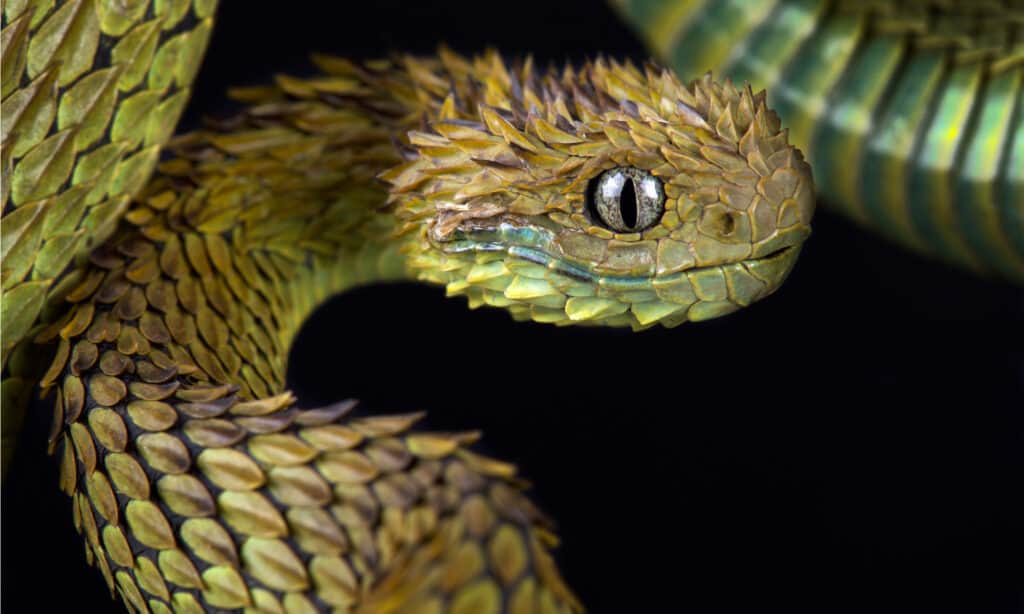
reptiles4all/Shutterstock.com
Bush vipers in general are incredibly weird and stunningly beautiful, but the weirdest member of the Atheris genus is most certainly the hairy bush viper. These snakes are instantly recognizable thanks to their brightly-colored, heavily keeled scales. The scales are so heavily keeled and outward-pointing that they give the snake a distinctly spiny or “hairy” appearance, hence its common name.
Like all other bush vipers, the hairy bush viper is native to Central and East Africa. It is nocturnal and highly arboreal, living primarily in dense tropical forests. Because its habitats are so far and often isolated from human civilization, it is rare for the bush viper to interact with humans.
However, if you’re ever lucky enough to spot one of these oddly beautiful snakes in the wild, you definitely don’t want to get too close! Their venom is highly neurotoxic and cytotoxic, and without treatment, their painful bites can be fatal.
5. Rattlesnakes (Crotalus and Sistrurus genera; 36 species)
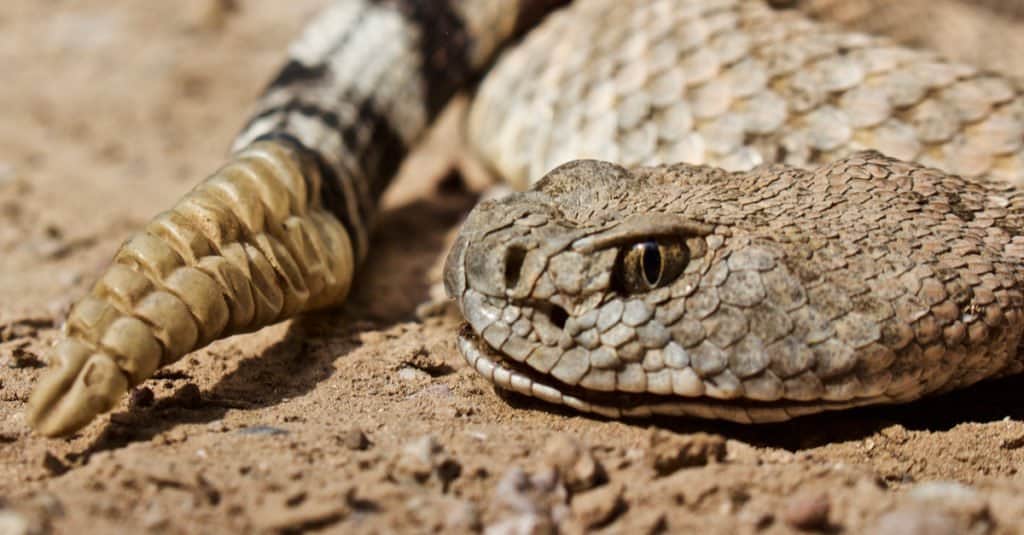
DMartin09/Shutterstock.com
There are a lot of different types of rattlesnakes out there–36 species and around 65 subspecies across two genera, in fact! Rather than highlight a single species, I’m giving this spot on the list to rattlesnakes as a group due to the unique tail rattles they all share.
A rattlesnake’s rattle is mainly used as a defense mechanism. By rapidly vibrating its tail, the snake can make the segments of its rattle rub against each other. This causes the distinct sizzling sound the rattlesnake uses to ward off potential predators.
Interestingly, a rattlesnake’s rattle is not present from birth! It actually grows with the snake as it matures. Baby rattlesnakes are born with just one segment, a “prebutton,” at the end of their tails. Every time they shed their skin as they age, a new layer, or segment, of keratin is added. These segments interlock and attach to one another, forming the entirety of the rattle.
Most snakes shed anywhere from three to six times a year, or around every other month or two. It is possible to determine roughly how old a rattlesnake is by how many individual segments make up its rattle!
6. Vine Snakes (Ahaetulla genus; 18 species)
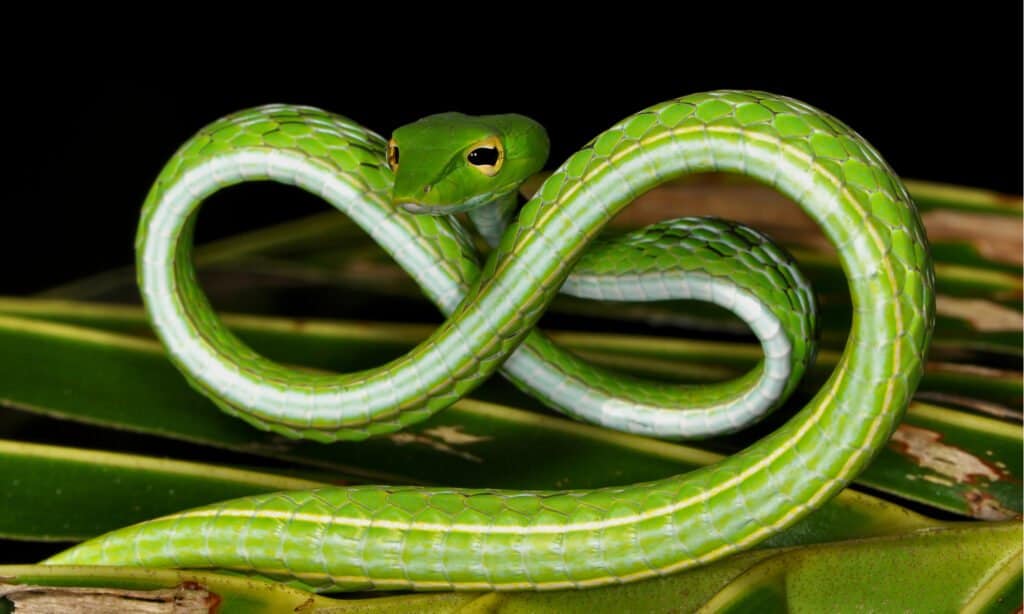
Ferdy Timmerman/Shutterstock.com
Vine snakes are another group of weird snakes that are simply too diverse and awesome to limit their spot on this list to just a single species! The Ahaetulla genus is composed of 18 different species of vine snakes, all of which are native to tropical areas throughout Asia.
True to their name, vine snakes are usually green in color with remarkably slender bodies and typically long, thin snouts. They are lightweight, highly arboreal, and very fast-moving predators perfectly suited for slinking about and dangling from tree branches. Though they don’t look very intimidating, they are expert ambush hunters!
Interestingly, most species of vine snakes also have uniquely horizontal, keyhole-shaped pupils. This odd-looking trait actually gives vine snakes exceptional eyesight.
7. Desert Horned Viper (Cerastes cerastes)
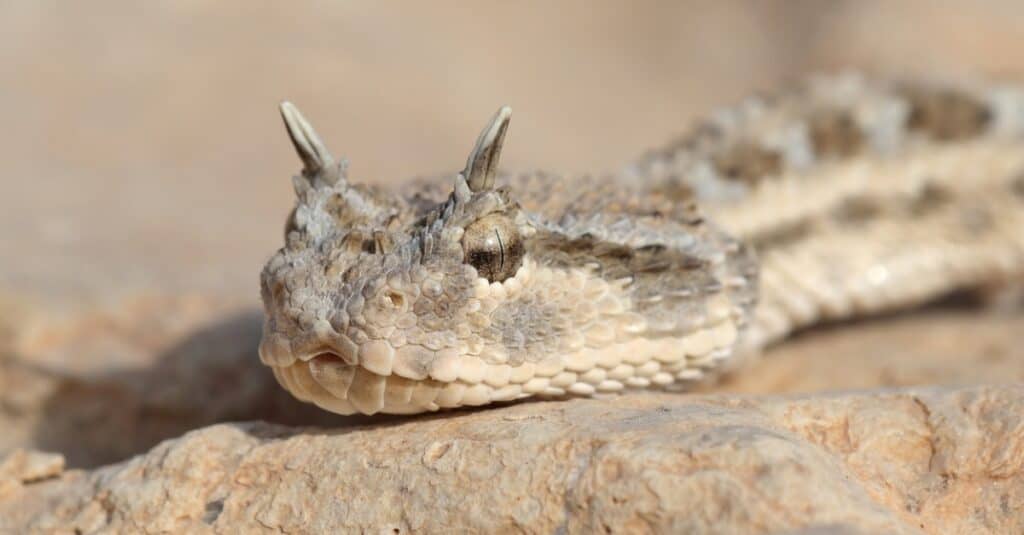
iStock.com/bogdanhoria
There are actually three different species of horned vipers within the Cerastes genus, but the desert or Saharan horned viper is the most well-known and recognizable. As their name suggests, these snakes have unusual scaled protrusions above each eye that resemble tiny horns!
Desert horned vipers are highly venomous and native to the driest, sandiest deserts in northern Africa and the Middle East. They are commonly spotted in Iraq, Syria, Libya, Egypt, Saudi Arabia, and Sudan, among several other surrounding countries.
These snakes’ beige coloration helps them camouflage themselves perfectly in the sand. As ambush hunters, they will wiggle their bodies in a sidewinding motion to partially submerge their bodies, where they will lie in wait for small rodents and birds to cross their path. Their “horns” actually help to keep sand out of their eyes.
8. Blind Worm Snake (Indotyphlops braminus)

Patrick K. Campbell/Shutterstock.com
If you were to ever see this incredibly weird snake in the wild, you’d almost definitely mistake it for an earthworm! The blind worm snake, also known as the brahminy blind snake, is one of many tiny, almost completely blind fossorial worm snake species within the Typhlopidae family. They typically only reach around 3 to 4 inches long, making them one of the smallest snakes in the world.
As you might be able to guess just by looking at them, blind worm snakes are non-venomous and completely harmless to humans. Their eyes are small and covered with protective, translucent scales, making them almost completely non-functional. Though they can technically see blurry shapes and differences in light, blind worm snakes have extremely poor vision overall.
Another strange yet fascinating trait about blind worm snakes is their ability to undergo parthenogenesis, a type of asexual reproduction! Virtually all individuals within the species are female. They can reproduce by either laying eggs or giving birth to live young depending on the favorability of surrounding soil conditions.
These strange little snakes are completely fossorial and spend almost their entire lives underground. They were originally native to parts of Africa and Asia, but they now live on almost every continent aside from Antarctica. You might even spot them in your garden from time to time!
9. Sea Snakes (Hydrophiinae subfamily)
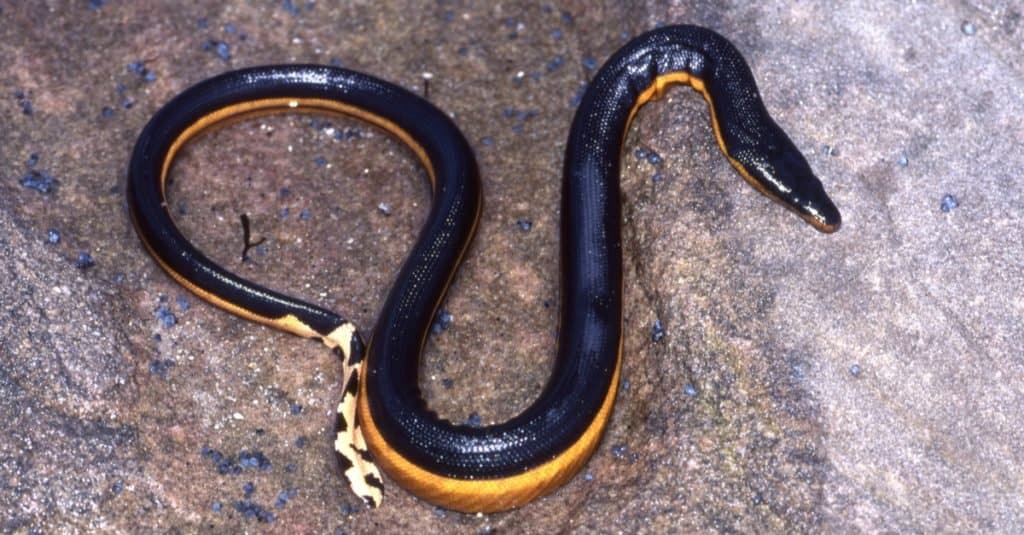
Ken Griffiths/Shutterstock.com
Another group of snakes worthy of a collective spot on this list is the sea snakes. The Hydrophiinae subfamily is made up of almost 70 different species, all of which spend basically their entire lives underwater. These weird snakes typically live in very warm waters of the Indian and Pacific oceans in tropical coastal areas near southern Africa, Southeast Asia, and Oceania.
To assist with their aquatic lifestyles, most sea snakes can hold their breath for long periods of time and even partially breathe through their skin! Their lungs have evolved over time to be much larger than those of terrestrial snakes. In addition to being able to store large amounts of air, the typical sea snake’s massive lung also helps keep it lightweight and buoyant.
Sea snakes also usually have muscular, paddle-shaped tails to help with swimming. This, combined with their lightweight, slender bodies, makes them very strong and agile swimmers.
All known sea snakes are venomous, but with ranging levels of danger. Some sea snake venom just causes swelling, nausea, and dizziness. But others can be quite deadly, inducing respiratory collapse and comas. Luckily, sea snakes generally try to keep their distance.
10. Hognose Snakes (3 genera; around 15 species)
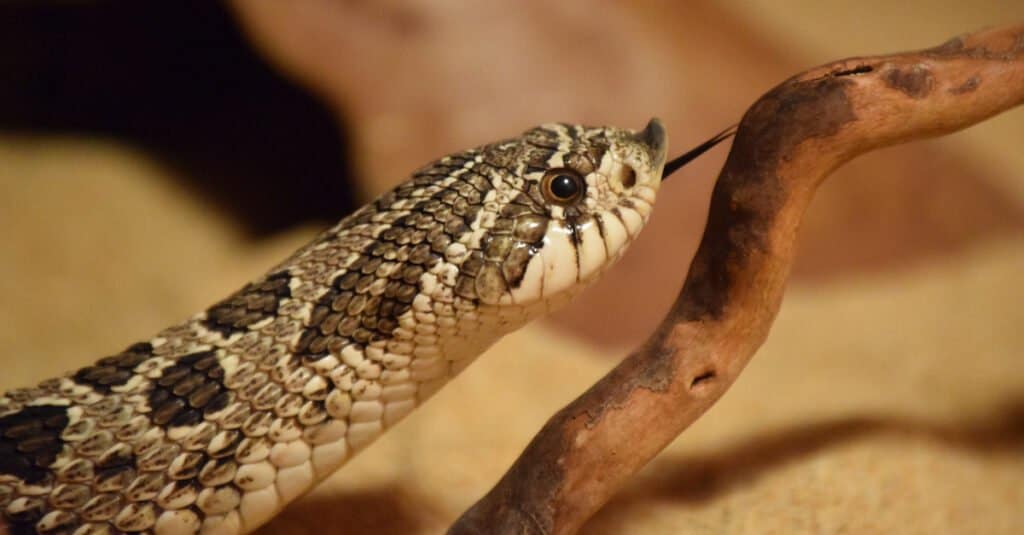
Bryn Thomas/Shutterstock.com
Finally, we cap off our list of the weirdest of the weird with the adorably strange hognose snakes. There are actually about 15 different species of hognose snakes spanning three different genera that live in wildly varying geographic regions from the Americas all the way to Madagascar. However, all of them share the same weird-but-cute upturned snout.
As highly fossorial animals, hognose snakes spend a lot of their time burrowing in sand, dirt, and leaf litter. Their snouts are perfectly sized and shaped for digging around in sandy soil. Their coloration varies from species to species, but most are shades of brown, beige, and tan. This drab color helps them blend in well with their surroundings.
Most species of hognose snakes are very shy, reclusive, and non-aggressive. Species within the Heterodon genus will even roll over and “play dead” if startled or threatened by a predator. Many varieties have also become popular within the pet trade.
The World’s 10 Weirdest Snakes Summary
| Rank | Name | Special Characteristic |
|---|---|---|
| #1 | Tentacled Snake (Erpeton tentaculatum) | Two mechanoreceptors on the snout |
| #2 | Flying Snakes (Chrysopelea genus) | Leaping across tree branches |
| #3 | Dragon Snake (Xenodermus javanicus) | Three rows of dragon-like scales |
| #4 | Hairy/Spiny Bush Viper (Atheris hispida) | Covered in colorful keeled scales |
| #5 | Rattlesnakes (Crotalus and Sistrurus genera) | Rattling tail defense mechanism |
| #6 | Vine Snakes (Ahaetulla genus) | Keyhole-shaped horizontal pupils |
| #7 | Desert Horned Viper (Cerastes cerastes) | ‘Horns’ protecting the eyes from sand |
| #8 | Blind Worm Snake (Indotyphlops braminus) | Asexual reproduction and appearing eyeless |
| #9 | Sea Snakes (Hydrophiinae subfamily) | Huge lung and paddle-shaped tail |
| #10 | Hognose Snakes (3 genera; around 15 species) | Playing dead and upturned snout for digging |
Up Next…
Discover the 10 Types of Water Snakes in the US– Don’t let it ruin your day at the lake- they’re not venomous!
The Largest Venomous Snake Ever Found in the US– Spoiler- it was over three times the average weight for this type of rattlesnake!
Discover the Monster Snake 5X Bigger than an Anaconda– Let’s just say we’re not that disappointed this one’s extinct…
Discover the “Monster” Snake 5X Bigger than an Anaconda
Every day A-Z Animals sends out some of the most incredible facts in the world from our free newsletter. Want to discover the 10 most beautiful snakes in the world, a “snake island” where you’re never more than 3 feet from danger, or a “monster” snake 5X larger than an anaconda? Then sign up right now and you’ll start receiving our daily newsletter absolutely free.
FAQs (Frequently Asked Questions)
What are the ugliest snakes in the world?
The ugliest snakes in the world is a subjective idea, but we’ve totaled up some of the contenders in our list of the 10 ugliest snakes. Many snakes have unusual features like horns that land them on the list.
More from A-Z Animals
Key Points
- There are five species of snake that can leap from branch to branch, appearing to fly through the air.
- Many of the weirdest snakes in the world live in Africa and Southeast Asia.
- Some snakes have ‘horns,’ ‘tentacles,’ shovel noses, tails that rattle or paddle, dragon-like scales, strange eyes, and one type appears to have no eyes at all.
Snakes are rather strange animals in general thanks to their bizarre anatomy, but have you ever wondered: what are the most unusual, odd, and absolute weirdest snakes in the entire world? What kind of freaky, fascinating, and otherwise unique serpents could top such a list?
Narrowing them down to just 10 different kinds is a bit of a challenge, but the species listed below are truly the weirdest of the weird. From snakes with extra appendages to snakes that can fly to snakes that live underground and look like worms, you’ll be amazed at just how peculiar they can be!
The following list is arranged in no particular order. All of these snakes are equally weird in their appearances, behaviors, and adaptations, just in different ways!
1. Tentacled Snake (Erpeton tentaculatum)

/Shutterstock.com
We begin our journey into the unusual with the aptly-named tentacled snake. As its name suggests, the tentacled snake has two small “tentacles” protruding from the top of its snout. But are these unique little tendrils just for show, or do they serve some kind of purpose? Well, the tentacles are actually highly sensitive mechanoreceptors that the snake uses to hunt prey!
As a highly aquatic snake, this species spends almost its entire life underwater. Since it’s a reptile, though, it doesn’t have gills to help it stay submerged. Instead, it has evolved to be able to hold its breath for up to 30 minutes at a time! These snakes can technically move (albeit very slowly) on land, but they rarely ever do except to make burrows for themselves in very muddy areas.
Native to Southeast Asia, tentacled snakes usually live in marshes and swamps or near rice paddies. They mainly prefer freshwater, but they have also adapted well to living in saltwater. Although they are venomous, their venom isn’t deadly or particularly dangerous to humans.
2. Flying Snakes (Chrysopelea genus; 5 species)

Vince Adam/Shutterstock.com
If the idea of a flying snake terrifies you, you’re certainly not alone! In reality, though, this snake’s name is a bit of an exaggeration. They don’t sprout wings or zoom around like birds of prey by any means. Instead, these highly arboreal snakes are able to flatten their lightweight yet muscular bodies to glide from tree to tree.
The way flying snakes such as the ornately colored paradise flying snake glide is actually very advanced! To put it as concisely as possible, they climb trees using their strong abdominal muscles, and, when they need to hop to another nearby branch (or even another tree entirely!), they will push their bodies up into the air away from the branch and take a huge leap.
Then, while in mid-air, a flying snake will stretch out and flatten its ribs and rapidly undulate its body. These combined motions turn the snake into a sort of makeshift wing, allowing it to quickly yet gracefully glide impressive distances.
There are five species of flying snakes within the Chrysopelea genus, all of which are native to Southeast Asia. They spend most of their lives high up in the canopies of trees in humid, dense jungles and forests.
3. Dragon Snake (Xenodermus javanicus)

/Shutterstock.com
We started with weird snakes that live in the water, then in trees, and now, we’re on to a species that spends much of its life underground. This strange serpent has several common names, including the Javan mudsnake and Javan tubercle snake, but its most popular moniker by far is simply the dragon snake. It is the sole member of its genus, Xenodermus.
The dragon snake’s main common name comes from its unusual yet beautiful dragon-like scalation. Its body is mostly jet black with three raised rows of keeled scales running down its entire length. Its underside is typically a light grey. Dragon snakes are fairly small and slender at only around 25 inches in length.
Unfortunately, these captivating animals are nocturnal and very reclusive, so they aren’t seen often by humans in the wild. They are semi-fossorial, so they spend a lot of time burrowing in the dirt, leaf litter, and mud in low-lying swamps and forests throughout the Malay Peninsula in Southeast Asia.
4. Hairy/Spiny Bush Viper (Atheris hispida)

reptiles4all/Shutterstock.com
Bush vipers in general are incredibly weird and stunningly beautiful, but the weirdest member of the Atheris genus is most certainly the hairy bush viper. These snakes are instantly recognizable thanks to their brightly-colored, heavily keeled scales. The scales are so heavily keeled and outward-pointing that they give the snake a distinctly spiny or “hairy” appearance, hence its common name.
Like all other bush vipers, the hairy bush viper is native to Central and East Africa. It is nocturnal and highly arboreal, living primarily in dense tropical forests. Because its habitats are so far and often isolated from human civilization, it is rare for the bush viper to interact with humans.
However, if you’re ever lucky enough to spot one of these oddly beautiful snakes in the wild, you definitely don’t want to get too close! Their venom is highly neurotoxic and cytotoxic, and without treatment, their painful bites can be fatal.
5. Rattlesnakes (Crotalus and Sistrurus genera; 36 species)

DMartin09/Shutterstock.com
There are a lot of different types of rattlesnakes out there–36 species and around 65 subspecies across two genera, in fact! Rather than highlight a single species, I’m giving this spot on the list to rattlesnakes as a group due to the unique tail rattles they all share.
A rattlesnake’s rattle is mainly used as a defense mechanism. By rapidly vibrating its tail, the snake can make the segments of its rattle rub against each other. This causes the distinct sizzling sound the rattlesnake uses to ward off potential predators.
Interestingly, a rattlesnake’s rattle is not present from birth! It actually grows with the snake as it matures. Baby rattlesnakes are born with just one segment, a “prebutton,” at the end of their tails. Every time they shed their skin as they age, a new layer, or segment, of keratin is added. These segments interlock and attach to one another, forming the entirety of the rattle.
Most snakes shed anywhere from three to six times a year, or around every other month or two. It is possible to determine roughly how old a rattlesnake is by how many individual segments make up its rattle!
6. Vine Snakes (Ahaetulla genus; 18 species)

Ferdy Timmerman/Shutterstock.com
Vine snakes are another group of weird snakes that are simply too diverse and awesome to limit their spot on this list to just a single species! The Ahaetulla genus is composed of 18 different species of vine snakes, all of which are native to tropical areas throughout Asia.
True to their name, vine snakes are usually green in color with remarkably slender bodies and typically long, thin snouts. They are lightweight, highly arboreal, and very fast-moving predators perfectly suited for slinking about and dangling from tree branches. Though they don’t look very intimidating, they are expert ambush hunters!
Interestingly, most species of vine snakes also have uniquely horizontal, keyhole-shaped pupils. This odd-looking trait actually gives vine snakes exceptional eyesight.
7. Desert Horned Viper (Cerastes cerastes)

iStock.com/bogdanhoria
There are actually three different species of horned vipers within the Cerastes genus, but the desert or Saharan horned viper is the most well-known and recognizable. As their name suggests, these snakes have unusual scaled protrusions above each eye that resemble tiny horns!
Desert horned vipers are highly venomous and native to the driest, sandiest deserts in northern Africa and the Middle East. They are commonly spotted in Iraq, Syria, Libya, Egypt, Saudi Arabia, and Sudan, among several other surrounding countries.
These snakes’ beige coloration helps them camouflage themselves perfectly in the sand. As ambush hunters, they will wiggle their bodies in a sidewinding motion to partially submerge their bodies, where they will lie in wait for small rodents and birds to cross their path. Their “horns” actually help to keep sand out of their eyes.
8. Blind Worm Snake (Indotyphlops braminus)

Patrick K. Campbell/Shutterstock.com
If you were to ever see this incredibly weird snake in the wild, you’d almost definitely mistake it for an earthworm! The blind worm snake, also known as the brahminy blind snake, is one of many tiny, almost completely blind fossorial worm snake species within the Typhlopidae family. They typically only reach around 3 to 4 inches long, making them one of the smallest snakes in the world.
As you might be able to guess just by looking at them, blind worm snakes are non-venomous and completely harmless to humans. Their eyes are small and covered with protective, translucent scales, making them almost completely non-functional. Though they can technically see blurry shapes and differences in light, blind worm snakes have extremely poor vision overall.
Another strange yet fascinating trait about blind worm snakes is their ability to undergo parthenogenesis, a type of asexual reproduction! Virtually all individuals within the species are female. They can reproduce by either laying eggs or giving birth to live young depending on the favorability of surrounding soil conditions.
These strange little snakes are completely fossorial and spend almost their entire lives underground. They were originally native to parts of Africa and Asia, but they now live on almost every continent aside from Antarctica. You might even spot them in your garden from time to time!
9. Sea Snakes (Hydrophiinae subfamily)

Ken Griffiths/Shutterstock.com
Another group of snakes worthy of a collective spot on this list is the sea snakes. The Hydrophiinae subfamily is made up of almost 70 different species, all of which spend basically their entire lives underwater. These weird snakes typically live in very warm waters of the Indian and Pacific oceans in tropical coastal areas near southern Africa, Southeast Asia, and Oceania.
To assist with their aquatic lifestyles, most sea snakes can hold their breath for long periods of time and even partially breathe through their skin! Their lungs have evolved over time to be much larger than those of terrestrial snakes. In addition to being able to store large amounts of air, the typical sea snake’s massive lung also helps keep it lightweight and buoyant.
Sea snakes also usually have muscular, paddle-shaped tails to help with swimming. This, combined with their lightweight, slender bodies, makes them very strong and agile swimmers.
All known sea snakes are venomous, but with ranging levels of danger. Some sea snake venom just causes swelling, nausea, and dizziness. But others can be quite deadly, inducing respiratory collapse and comas. Luckily, sea snakes generally try to keep their distance.
10. Hognose Snakes (3 genera; around 15 species)

Bryn Thomas/Shutterstock.com
Finally, we cap off our list of the weirdest of the weird with the adorably strange hognose snakes. There are actually about 15 different species of hognose snakes spanning three different genera that live in wildly varying geographic regions from the Americas all the way to Madagascar. However, all of them share the same weird-but-cute upturned snout.
As highly fossorial animals, hognose snakes spend a lot of their time burrowing in sand, dirt, and leaf litter. Their snouts are perfectly sized and shaped for digging around in sandy soil. Their coloration varies from species to species, but most are shades of brown, beige, and tan. This drab color helps them blend in well with their surroundings.
Most species of hognose snakes are very shy, reclusive, and non-aggressive. Species within the Heterodon genus will even roll over and “play dead” if startled or threatened by a predator. Many varieties have also become popular within the pet trade.
The World’s 10 Weirdest Snakes Summary
| Rank | Name | Special Characteristic |
|---|---|---|
| #1 | Tentacled Snake (Erpeton tentaculatum) | Two mechanoreceptors on the snout |
| #2 | Flying Snakes (Chrysopelea genus) | Leaping across tree branches |
| #3 | Dragon Snake (Xenodermus javanicus) | Three rows of dragon-like scales |
| #4 | Hairy/Spiny Bush Viper (Atheris hispida) | Covered in colorful keeled scales |
| #5 | Rattlesnakes (Crotalus and Sistrurus genera) | Rattling tail defense mechanism |
| #6 | Vine Snakes (Ahaetulla genus) | Keyhole-shaped horizontal pupils |
| #7 | Desert Horned Viper (Cerastes cerastes) | ‘Horns’ protecting the eyes from sand |
| #8 | Blind Worm Snake (Indotyphlops braminus) | Asexual reproduction and appearing eyeless |
| #9 | Sea Snakes (Hydrophiinae subfamily) | Huge lung and paddle-shaped tail |
| #10 | Hognose Snakes (3 genera; around 15 species) | Playing dead and upturned snout for digging |
Up Next…
Discover the 10 Types of Water Snakes in the US– Don’t let it ruin your day at the lake- they’re not venomous!
The Largest Venomous Snake Ever Found in the US– Spoiler- it was over three times the average weight for this type of rattlesnake!
Discover the Monster Snake 5X Bigger than an Anaconda– Let’s just say we’re not that disappointed this one’s extinct…
Discover the “Monster” Snake 5X Bigger than an Anaconda
Every day A-Z Animals sends out some of the most incredible facts in the world from our free newsletter. Want to discover the 10 most beautiful snakes in the world, a “snake island” where you’re never more than 3 feet from danger, or a “monster” snake 5X larger than an anaconda? Then sign up right now and you’ll start receiving our daily newsletter absolutely free.







